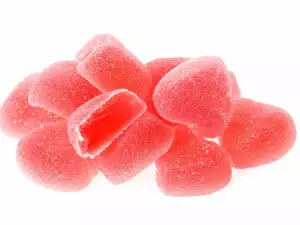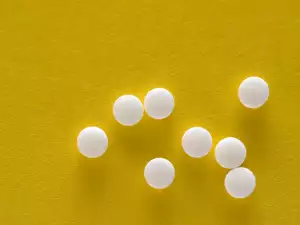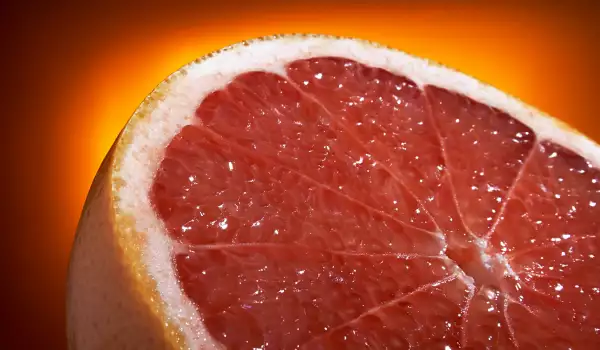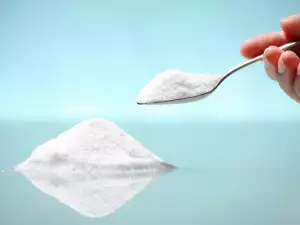Neohesperidin dihydrochalcone is a compound extracted from citruses and is used as a sweetener. It is known by other names, including neohesperidin DC or simply NHDC. The compound is also used as a food additive known as Е959. It is quickly absorbed by the human body.
On its own the substance is a white powder, odorless, with an expressed sweet taste. Upon consumption it leaves behind a light minty sensation. This food additive is many times sweeter than sucrose. Neohesperidin dihydrochalcone has very stable physical properties. Its boiling point varies between 310°F (152°C) and 310°F (154°C).
It can be stored in the form of solutions, powders and food products. The compound dissolves well in hot water. It has a medium solubility level in cool water. It does not dissolve in lipid solvents.
Naturally, neohesperidin dihydrochalcone is found in a substance found in grapefruits. Even though its primary source is a natural product, NHDC is not considered a completely harmless sweetener in every country.
History of Neohesperidin Dihydrochalcone
As with most great discoveries, the sweetener neohesperidin dihydrochalcone was also discovered by accident. The event took place during the 60s of the last century in the US. Scientists had been looking for a way to decrease the bitterness of grapefruit juice. The bitter flavonoid present in the composition of the citrus is called neohesperidin.
After researchers hydrogenated neohesperidin, the compound neohesperidin dihydrochalcone was created, distinguished by its sweet taste. This became a premise for the beginning of its use as a sugar substitute.
At the end of the last century, the European Union approved Е959 as an artificial sweetener. However, the American FDA has still not approved this substance.
Use of Neohesperidin Dihydrochalcone
Neohesperidin dihydrochalcone is mostly used in the food industry as a sweetener, as well as a way to highlight a particular taste. Frequently, this sweetener is combined with others, among which are aspartame, sucralose and acesulfame potassium.
As a food additive, Е959 is found in a wide range of food products where crystallized sugar is absent for one reason or another. It is primarily put into milk, cream, ice creams and all kinds of other dairy products. It is found in different sauces, such as mayonnaise, ketchup and mustard. It is used in the production of salami, sausages and others.

NHDC is present in gum, chewable candy, lollipops, breath mints, jelly bonbons, dried fruits, jams, jellies, purees. It can be found in sandwiches, snacks, cereals, wafers, biscuits and all kinds of baked goods.
Manufacturers put neohesperidin dihydrochalcone in mousses, creams and puddings as well. One may also come across this sweetener in shakes, juices, nectars, sodas, liqueurs, beer, canned fish, marinades for seafood preservation, mixed pickles, chutneys, compotes and even weight loss food products.
The applications of neohesperidin dihydrochalcone do not end here. The compound is found in some cosmetic products as well. You can see it listed in toothpaste and mouthwash ingredients.
Food additive Е959 is used in the pharmaceutical industry as well - in cough syrups, vitamin complexes, lozenges and more.
Dosage of Neohesperidin Dihydrochalcone
Currently, increased intake of neohesperidin dihydrochalcone is not known to cause any serious undesirable reactions. It has been determined that the intermediate dose of about 750 mg of NHDC per 2 lb (1 kg) of body weight per day have no marked effect on the body.
Benefits of Neohesperidin Dihydrochalcone
Without a doubt, this sweetener is of especially great benefit to those suffering from diabetes. According to experts, the food additive Е959 does not raise blood sugar levels in the body and because of this, people who are sensitive to regular sugar can eat sweets containing it without worry.

The compound is also useful for those who are trying to shed some extra pounds; it is used in the production of low-calorie/diet food products.
By consuming neohesperidin dihydrochalcone (which is currently being used with a relatively decent reputation) we can avoid other dangerous sugar substitutes such as cyclamate (E952), acesulfame K (E950), aspartame (Е951) and saccharin (E954).
For years now they have been associated with unpleasant side effects, including nausea, dizziness, loss of appetite, headache, blisters, impaired vision and many other issues.
Dangers of Neohesperidin Dihydrochalcone
Since the sweetener neohesperidin dihydrochalcone is of high interest to scientists, it has undergone various types of testing but its study is just beginning. Presently, its use is not known to cause health harm.
But according to some scientists the use of the food additive can cause softer stools, light depression and decreased appetite. They say that these conditions are temporary and appear only in the first few days of the taking of the substance.







Comments